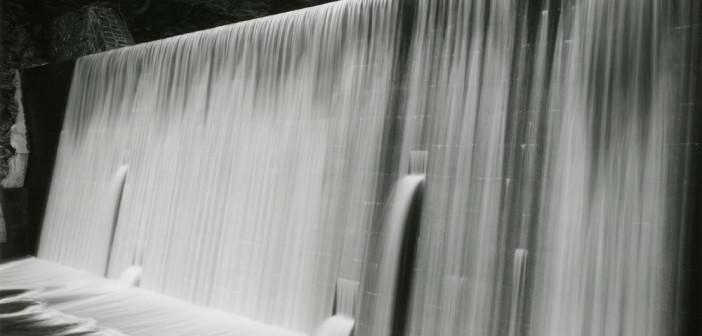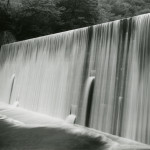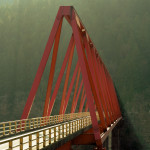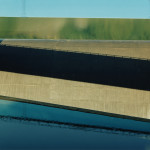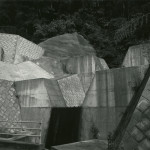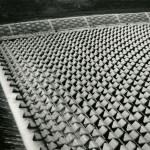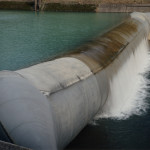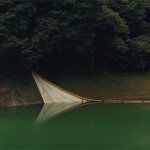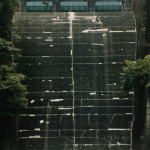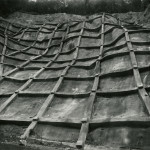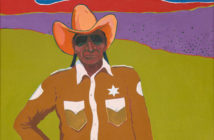The opening reception of Toshio Shibata, Constructed Landscapes at PEM on Wednesday April 17 drew well over 200 visitors, from affiliated artists to friends of the museum (which includes, as it turns out, the consulate of Japan in Boston), North Shore patrons and benefactors and, fortunately for me, crackerjack press members with a penchant for the arts. Under the soaring ceiling of the atrium, a trio played an accompaniment to the mingling of attendees who greeted in anticipation of Shibata’s exhibition, culled from the last thirty years of his career. In attendance were curator Phillip Prodger and the artist himself, lovingly called Toshio by the curatorial assistants I spoke with. As we enjoyed the warm and welcoming hospitality of PEM staff--one that extended to an open bar serving Japanese-inspired cocktails and scrumptious sushi concoctions--Prodger spoke of his deep admiration for Shibata’s work, which he recounted seeing for the very first time in a 1991 edition of Aperture magazine. Immediately recognizing not only the striking beauty of Shibata’s photographs, but their "influential idea" of what landscape photography could be, Prodger’s "heart skipped a beat."
Fast forward twenty-two years. I was eager to see the 28 photographs on view in the Hilborn Gallery and Japan Room. I had heard from curatorial assistants Nicole Pearson and Madeleine Kropa that Shibata had given the curators free rein to arrange his work in the galleries, and they had created multiple displays before perfecting the final exhibition’s organization by, it appears to me, color palette and geometric form. For his own part, Shibata had spoken (somewhat softly) from the podium of the "magic of photography." So it was not without some expectation that we were ushered into the third floor gallery together in a steady stream. At the top of the staircase to the Hilborn, a quote by none other than Robert Adams set the tone: "I tried to keep in mind a phrase from a novel by Kawabata: ‘My life, a fragment of a landscape.’ The same applied, I thought, to each of us..."
I was struck by the quote in relation to Shibata’s aesthetic, but perhaps not for the obvious reasons. As evidenced by the 25 photographs in the Hilborn, and three set fittingly amidst the objects of the Japan Room, Shibata is no ordinary landscape photographer; although he largely photographs, by his own admission, completely ordinary infrastructure: dams especially, water catchments, bridges and roads, and other feats of engineering that strike the eye as being unexceptional and quite often unidentifiable. The wonder of his artistry is that the mundane constructions and natural landscapes in which they are erected come together, their seams showing, into objects of great mystery. I was not alone in being unable to identify many of the structures in his work, and I took some pleasure, I’ll admit, in attendees’ eagerness to figure out those constructions they would otherwise completely disregard. But more than an indiscernible ontology of engineering, the enigma of Shibata’s photographs inheres in the abstractions he weaves together and out of the altered landscape. He does, it seems, create fragments.
Like other contemporary social landscape photographers, Shibata explores the geopolitical forces shaping the natural world, but not in any immediate way. His approach is more subtle than suburban sprawl or environmental degradation. The politics of the built environment can be discerned through the very shapes of the structures he photographs, as in Hinohara Village, 1994, in which the conflicting concrete latticework on a hillside is the mark of competing corporate ownership of the area and their distinctive engineering styles. In his focus on the natural landscape as it is altered by human production and development, Shibata’s work reminds me of that of the New Topographics photographers of the mid-1970s. With this in mind, I asked the artist if he had selected the Adams quote for his exhibition. He had not, though he expressed his deepest admiration for Adams’ work. Indeed, the relation between Shibata’s gorgeous, atmospheric images and New Topographics stops, for me, at the subject matter, as I suspect it did for the curators. Rather, the photographs in Constructed Landscapes reveal that Shibata is, as Prodger had long ago suspected, an artist with a new idea.
Unlike the neutral stance (whatever that was thought to mean) and determined objectivity of New Topographics, Shibata does not strive for any lack of personal style. He’s got plenty of style. His photographs are striking, eye-catching compositions to which you will feel compelled to return. But they’re more than that. Revealing overlapping concrete walls in gridded formation, roads that mimic the mountains through which they pass, lines of waterways and waterfalls, nets and blockish domes, they are strange geometries. I asked Shibata if he had intentionally focused on forms, abstractions, shapes, drawing and building them from the landscape. He replied that he eliminates any trace of the sky or horizons in his work for just this reason, to create visually confusing and extraordinary forms out of ordinary and unnoticed structures. In this sense, Shibata transforms sites of construction into formalist abstractions that are rivetingly enigmatic. His lush colored photographs, shown for the first time in the United States, are interspersed with detailed black & whites that give the lie to the idea that straight photography produces documents. In Shibata’s case, it produces expressive abstractions from mundane objects at the site of collision between human production and nature. This, I think, is the real inventiveness of Shibata’s work, not his obvious departure from the picturesque aesthetic that defines much Japanese art, but not necessarily its contemporary photography. While he does not photograph traditional temples or sweeping mountaintops, his work is, after all, picturesque, even though its subject matter may not be.
Well over a century before photography would be accepted as a serious art form, PEM acquired its first photograph, a daguerrotype. It was 1840, just one year after the invention of the medium. Today, PEM is committed to bringing the work of international photographers (and often the photographers themselves) to new audiences. Ever motivated to push the boundaries of what photography can do, they continue to pursue new ideas, Toshio Shibata’s among them.
- Toshio Shibata Kuroiso City, Tochigi Prefecture, 1989 © Toshio Shibata
- Toshio Shibata Okawa Village, Tosa County, Kochi Prefecture, 2007 © Toshio Shibata
- Toshio Shibata Hanno City, Saitama Prefecture, 2006 © Toshio Shibata
- Toshio Shibata Matsuda Town, Ashigarakami County, Kanagawa Prefecture, 1991 © Toshio Shibata
- Toshio Shibata Tomuraushi, Kamikawa County, Hokkaido, 1988 © Toshio Shibata
- Toshio Shibata Sukumo City, Kochi Prefecture, 2012 © Toshio Shibata
- Toshio Shibata Okutama Town, Nishitama County, Tokyo, 2006 © Toshio Shibata
- Toshio Shibata Okutama Town, Nishitama County, Tokyo, 2006 © Toshio Shibata
- Toshio Shibata Tajima Town, Minamiaizu County, Fukushima Prefecture, 1989 © Toshio Shibata
Toshio Shibata, Constructed Landscapes is on view April 20 - October 6, 2013 at the Peabody Essex Museum.

